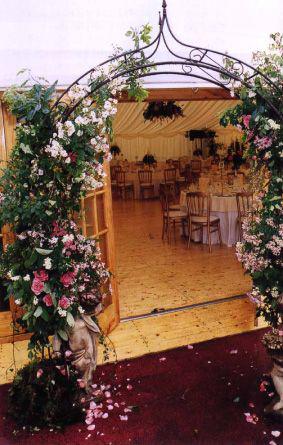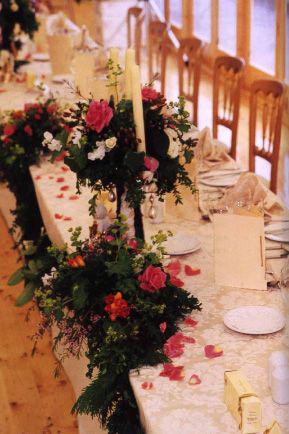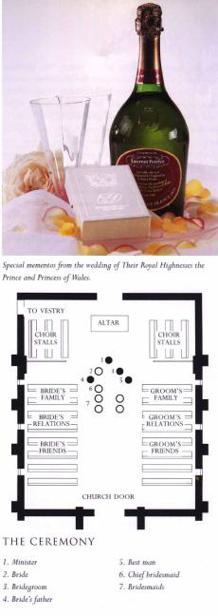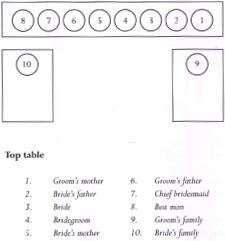In The Royal Manner (16 page)

WEDDING PRESENTS
A wedding list service is offered by department stores and other more specialist shops. The staff will help you compile a list of present suggestions tailored to your needs and requirements. Although some guests will want to give you something more personal, most will be grateful to receive a contact address and telephone number for your chosen store so that they can choose something from the list. Presents will be wrapped by the shop, labelled and delivered to the bride and groom at their contact address near to the wedding day.
PHOTOGRAPHS AND VIDEO
Everyone will want to see photographs of your wedding, so a photographic record of the most important day of your life (so far) is essential. A professional photographer is a must. Visit a variety of photographers and view their portfolios before making a decision. It might be useful to visit the church and reception venue with your photographer to decide exactly how to use the locations to their best advantage. Most priests will be happy for photography inside the church, but some consider flash lights an intrusion. This also applies to the use of video recorders. Remember the church is first and foremost a place of worship, so you must ask permission before the wedding.
TRANSPORT
It is practical to assume that the wedding party will require transportation to the ceremony and from there on to the wedding breakfast. A horse and carriage or a vintage car will provide perfect ‘props’ for photographic opportunities. It simply depends on your personal taste and style.
FLOWERS
An essential ingredient on your wedding day will be the flowers, from the bridal bouquet and buttonholes through to the church and wedding breakfast table displays.
The choice of flowers is largely personal, but a lot will depend on the season and the budget. The flowers will provide a beautiful clement of style, colour and perfume on the day.
Have you ever wondered why a bride carries flowers? Flowers are a symbol of fertility and children. Strong-smelling herbs used to be entwined amongst the flowers as it was believed that the pungent smell of rosemary and thyme would help ward off evil spirits, bad luck and ill-health. Unless the bride is allergic to fresh flowers or wishes to keep her bouquet indefinitely, I consider it essential for her to carry fresh flowers on her wedding day. The Queen carried a traditional shower bouquet containing flowers from all regions of her Kingdom and Commonwealth on her wedding day, and the Princess of Wales carried a bouquet which contained stephanotis, roses, lilies of the valley and sweet peas. You may w-ant to select flowers which have a specific meaning, and I have compiled a list of common flowers and their connotations which you might find interesting (see page 82).

Before you decide on the flowers, think of the theme, style and colour of your wedding outfit. The bridesmaids may carry similar small arrangements to the bride's bouquet. Young bridesmaids may find it easier to carry a posy or small basket of flowers. Recently I saw a little girl carrying a ‘wand’ complete with a glittering star! You may also want to wear flowers in your hair, and provide headdresses for your bridesmaids.
FLOWERS AND THEIR MEANINGS
ACACIA secret love
APPLE BLOSSOM perfection
BLUEBELL lasting love
CHRYSANTHEMUM (RED) love
CHRYSANTHEMUM (WHITE) truth
DAFFODIL regard
DAHLIA good taste
FORGET-ME-NOT true love
GERANIUM true friendship
HOLLY enchantment
HONEYSUCKLE bonds of love
IVY fidelity
JASMINE sensuality
LILAC first emotions
LILY OF THE VALLEY happiness
MIMOSA sensitivity
ROSE love
SNOWDROP hope
STEPHANOTIS travel
STOCK lasting beauty
SUNFLOWER adoration
TULIP love
VIOLET faithfulness
WISTERIA I cling to you
If the men are wearing morning dress or frock coats then you will need to provide buttonholes. There is nothing more attractive or stylish than a simple rose or a few stems of lily of the valley, if in season.
At the church, the doorway can be transformed with climbing roses in baskets or pots, or topiary trees on either side of the door. One or two displays of large lilies like Longi or Casablanca look stunning at the altar. Make sure that the stamens are removed to avoid any mishaps on dresses and cassocks! The ends of pews can be decorated with simple hand-tied natural posies. If there is another wedding in the church on the same day, you will have to consult with the other families when it comes to decorating the church, and a compromise will have to be reached.

You may be advised to check the church's regulations on the scattering of petals or confetti; I have seen bridesmaids scattering rose petals from baskets all the way up the aisle, much to the disapproval of the priest.
At the wedding breakfast, you will probably want to decorate each table with a small arrangement. Candles look good, especially floating ones, if it is an evening reception. The top table can be decorated more grandly with swags of greenery draping up and around the sides of the table—ivy works particularly well for this.
Whatever your taste, the flowers you choose will add an extra special dimension to your wedding day.*
THE WEDDING CAKE
The centrepiece of your wedding breakfast will be your cake. A local baker or cake specialist will make the cake to your specification. Although it is traditionally a rich fruit cake, many couples now are choosing a chocolate or plain sponge cake in preference. The caterers should provide a knife for the important ceremony of the ‘cutting of the cake’. Sometimes pieces of cake are boxed and sent to those who were unable to attend, and small cake boxes are usually offered when your order your stationary. You may also like to explore the idea of ‘favours’. This is an American idea of providing your guests with a small ‘keepsake’ by which to remember your happy day. These are usually placed on the table at the wedding breakfast. Traditionally sugared almonds are wrapped in small pieces of sheer fabric, but increasingly other gifts like small boxes of chocolates or miniature bottles of brandy or champagne are given. Another excellent idea is to give disposable cameras for your guests to take pictures of incidents that you might miss.
THE WEDDING DAY
After months of planning, the big day arrives and, although no two weddings are alike, I have compiled a running order to guide you through your big day, explaining the correct etiquette where appropriate.
The ushers, best man and groom are the first to arrive at the church, and should be in place about thirty minutes before the ceremony begins. The ushers control the flow of die congregation and are responsible for handing out the ‘Order of Services’ and for making sure that the guests sit in their proper places. The first two rows of seating are allocated to the immediate family. Guests of the bride and the bride's family sit on the left-hand side of the church, and the groom's on the right-hand side. The best man and groom take their seats at the front right-hand side of the church. The congregation arrives about fifteen to twenty minutes before the ceremony begins. The groom's parents will then arrive and be shown to their seats, directly behind their son, by a specially designated usher. It is worth noting here that divorced parents of the bride and groom should sit together. Second husbands and wives should sit further behind with friends and the rest of the family. The bridesmaids are the next to arrive, with the bride's mother, and They wait at the entrance for the bride to arrive with her father. The bride's mother is the last to be seated, again by a designated usher, and the service is ready to begin.

As the processional music starts, the congregation stands, the groom and best man take their place at the altar steps, and the bride, with her bridesmaids and pageboys, walks down the aisle, on the left arm of her father. It is traditional for the bride to wear her veil covering her face until she reaches the altar, and then it is lifted to greet the groom. The chief bridesmaid may help with the veil and train, and will take the bridal bouquet from the bride. The bride's father joins his wife once he has ‘given the bride away’.
The ceremony begins and the marriage takes place. The couple sign the register in the vestry in the presence of the best man, bridesmaids and both sets of parents to witness their signatures.
On leaving the church, the bride leaves on the arm of her husband, followed by the bridesmaids and pageboys. The chief bridesmaid is escorted by the best man, followed by the bride's mother with the groom's father, and the groom's mother escorted by the bride's father. Outside the church, photographs usually take place and then everyone departs to the reception.
The first meal after the wedding ceremony is traditionally called the wedding breakfast. The bride and groom should be the first to arrive at the venue, shortly followed by the bridesmaids, best man and both sets of parents. It may be appropriate for the immediate party to form a reception line as the guests enter, thus making sure everyone has an official greeting. Your guests should then be offered a drink such as champagne, buck's fizz, sherry or Pimm's, plus a non-alcoholic choice as well. After about thirty minutes, the toast master or best man asks everyone to take their seats at the tables.
Once your guests have found their seats, the toast master or best man will ask everyone to stand and welcome the bride and groom ‘Mr and Mrs……’. It is customary for the guests to clap whilst the couple take their places at the ‘top table’. The meal is then served.
SEATING PLAN

THE SPEECHES
These begin before the wedding cake is cut, and the first to be announced by the toast master or best man is the bride's father. His speech is often poignant and moving and will usually recall memories of his daughter's life. He also welcomes the bridegroom's parents. He then proposes a toast to the future health and happiness of the newly married couple, and everyone stands to raise their glasses, not ‘clink’ them together, to the bride and groom, who remain in their seats.
